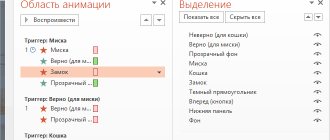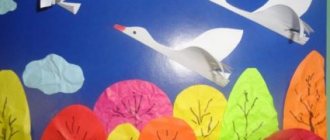Poems about wintering birds
Magpie Everywhere you will notice a magpie Fashionista in black, but with a white side, She chirps like a grasshopper With a long tail and is slightly chatty And before that which sparkles and shines The magpie-thief cannot resist. Riddle Where there is noise and din, there she is, There is a rumor about her in the forest: That there is nothing more talkative than this bird, That she can’t sit still, That where there is a fight, a quarrel, a squabble, It’s definitely circling there... (Magpie)
Woodpecker The trees have their own doctor, Not an ordinary one, but a forest one, He simply talks to birch and pine. Without medicines or instruments, He will heal the patient, He flew in and sat on a branch - How are you? knock-knock-knock... Riddle Who is this in the red beret, In the black satin jacket? He doesn’t look at me, he keeps knocking, knocking, knocking. (Woodpecker)
Pigeons People on the street raised their heads: Pigeons, pigeons, white pigeons! The city is filled with the noise of their wings, The dove reminded people of peace. Riddles This bird is a symbol of peace, Attics are its apartment, Where squares and fountains are, Constantly looking for crumbs! (Pigeon)
Bullfinch Like a Russian hero, A ruby bullfinch sat on a rowan branch! He looked around vigilantly: “Where is the danger?” - not to be seen. Whistling cheerfully and loudly, he began to peck the berries! Author: A. Vorobiev Riddle There are apples on the branches in winter! Collect them quickly! And suddenly the apples flew up, After all, this is... (Bullfinches)
The titmouse put on a yellow apron, and the titmouse flew to us. And he sits knocking on the window - I’ve been wanting to eat for a long time! Let me in, warm me up, treat me. I know the windows are good. I fly to them in winter. Author: T. Kazyrina Riddle As it gets colder in the forest, Birds fly to the city. Everyone is familiar with the yellow breast, They look for lard on the balconies. They often knock on our windows and whistle shrilly! (Tits)
Sparrow Sparrow - little sparrow - Head covered in feathers, Feathers ruffled, Eyes like peas. Don’t look at how small he is, Little is remote. Author: A. Alferova Riddle A small bird has legs, but cannot walk. Wants to take a step - It turns out to be a jump. (Sparrow)
Do you often use presentations in class?
Leave your answer in the comments. Tatiana 01/03/2021
About winter is accessible to children 4-5 years old. (Presentation and notes)
Gift for Dad on February 23 (With Your Own Hands)
Wall newspaper “Feed the birds in winter”
Wall newspaper “Feed the birds in winter!”
The goal of this project is to foster an ecological culture in preschool children, the desire to protect natural resources themselves and encourage others to do the same.
An interesting and significant campaign for nature conservation: “Feed the birds in winter!” ". During this event, the children and I made a wall newspaper. I present it to your attention.
Despite the preliminary work to familiarize children with wintering birds, the children distinguished them very poorly, confused wintering and migratory birds, and could not name them. I prepared pictures of birds. She suggested that the children cut them out and paste them on. But she warned that only those who name the wintering bird depicted on it will receive the picture. This greatly activated the children's memory! Pictures are laid out face down on the table.
All the pictures were sorted out, the children started cutting and pasting. The process itself also develops fine motor skills.
Next to the picture of the birds we pasted information about what the bird eats in winter. Thus, while working on the wall newspaper, we remembered and consolidated the names of wintering birds, clarified what they eat, and consolidated the skills of cutting and pasting. And how much fun the children got from working together!
I have prepared a booklet for parents “Feed the birds in winter! ” and inserted it into the pocket under the newspaper. Here's what we got:
Bullfinch
Jackdaw
Feed the birds in winter!!!
It is better to accustom yourself and the birds to a certain regime, filling the feeders once or twice a day, in the morning or morning and evening at the same time.
Pigeons, sparrows and ducks cannot survive winter without us. Feed with a specially prepared mixture or wheat, or better yet, barley. The best cereal is pearl barley, which is peeled barley. White bread is not the best food for pigeons, but in small quantities it is quite suitable (but fried pies, white bread, pizza, etc. are very harmful)
Caesars can use oatmeal, add unroasted seeds
Pearl barley is too hard for sparrows, but everything else that pigeons eat is also suitable for them. Sparrows prefer millet from grain.
Tits, nuthatches, woodpeckers, greenfinches, and jays are accustomed to looking for food themselves, but a third of the daily ration as a gift from a person will not be superfluous to them.
Unroasted sunflower seeds, medium-fat cottage cheese, scraped lean beef mixed with white breadcrumbs, grated hard-boiled egg, finely chopped fresh apple. On frosty days, it’s good to hang a piece of unsalted lard and put a piece of butter.
They enjoy eating watermelon and pumpkin seeds.
Bullfinches, fieldfare thrushes, waxwings, goldfinches, buntings, siskins and redpolls, pikas and wrens - these birds are real nomads, they don’t stop anywhere for a long time, so they don’t get used to human bait much.
Thrushes and waxwings in winter feed exclusively on the soft fruits of trees and shrubs - mountain ash, hawthorn and even snowberry. Their life completely depends on the presence of berries on the branches.
Bullfinches feed on the seeds of rowan, ash, and lilac.
Goldfinches, buntings, siskins and redpolls feed on weed seeds, and siskins and redpolls also feed on birch trees.
The pika and wren are strictly insectivorous birds and survive the winter by searching for insects hidden under the bark
Crows and magpies. It is better not to feed these birds. This is especially true for crows, whose numbers in cities exceed normal limits. The hooded crow is an omnivorous bird; its diet includes both plant foods and animals.
contraindicated. This is, firstly, everything fried and salted, black bread
It is best to feed birds away from their homes, choosing an area with convenient perches
thrush
Helping birds in winter: food
Even in winter, each individual species feeds on a specific type of food. Therefore, the species composition of visitors will depend on the filling of the feeder. Below you can find a description of the main feeds that can be used in winter feeding and their specific purpose.
What can you feed birds?
For winter feeding, you should prepare in advance: stock up on appropriate feed and build feeders (Figure 3). At the same time, you should know that not all products are beneficial for the feathered inhabitants of parks and forests, and some of them can even be harmful.
How people help birds in winter: general recommendations
In different regions of our country, the duration of the feeding season differs, which depends on climatic conditions, the harvest of natural feed and other reasons. The national average is 180 days and lasts from October to March inclusive. But even these dates are not precisely defined, because it often happens that mid-autumn is characterized by warm sunny weather, and birds can freely get food in their habitat. And vice versa, when early autumn brings with it unfavorable weather conditions - rain, sleet - the feeding season begins earlier.
Note: As a rule, special feeders are used for feeding, varying in shape and size. In places where it is necessary to attract a large number of individuals (in parks, alleys, squares), it is recommended to place entire feeding areas. They are square-shaped areas with sides of 5x5 m or 7x7 m, on the territory of which feeders are evenly located. Typically, such sites are located in places where it is convenient to serve them without disturbing the birds.
The first period of winter feeding is called bait and lasts from one to one and a half months (from mid-October to the end of November), the second - main - lasts about 90 days (from the beginning of calendar winter to the beginning of calendar spring), the final period lasts 10-25 days (approximately from March 1 to March 25) You should know that the most difficult period for birds is the main period, during which, as a result of low temperatures, the soil freezes and the ground is covered with a deep snow cover (Figure 2).
Figure 2. Anyone can help birds in the cold season
The feed rate is determined by the time and duration of the period. So, during the feeding period, food is placed in feeders in an amount of about 15-20% of the norm, since at this time the birds have the opportunity to get food on their own. During the main period there is absolute lack of food. At this time, birds need the maximum amount of feed, however, overfeeding them is not recommended, since this causes them to become food dependent, which leads to a decrease in natural resistance to infections, as a result of which the birds often die after stopping feeding for several days. Finally, in the final period, it is recommended to lay out from 60% to 80% of the full norm, continuing feeding until the first thawed patches appear on the ground.
How to help birds in winter
The smallest representatives of the bird family that remain for the winter need feeding the most. Their diet consists mainly of plants and insect pests. Therefore, in winter, when most of the usual food disappears, they move closer to human habitation in the hope of feeding and warming up (Figure 1).
Note: By helping birds during the cold season, we preserve their population, thereby providing ourselves with protection from various insects that destroy plants in forests, parks, gardens and household plots.
Figure 1. In winter, birds cannot do without human help.
Most often, people hang feeders filled with bird food. However, you should know that there are other ways to help birds in winter. For example, pour fresh warm water into a bowl to help keep you warm, or create a shelter where you can wait out bad weather. In addition, you can leave faded flower heads with seeds or viburnum berries as a treat for the winter.



